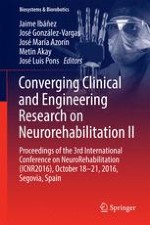2017 | OriginalPaper | Buchkapitel
Towards a Myoelectrically Controlled Virtual Reality Interface for Synergy-Based Stroke Rehabilitation
verfasst von : Denise J. Berger, Andrea d’Avella
Erschienen in: Converging Clinical and Engineering Research on Neurorehabilitation II
Aktivieren Sie unsere intelligente Suche, um passende Fachinhalte oder Patente zu finden.
Wählen Sie Textabschnitte aus um mit Künstlicher Intelligenz passenden Patente zu finden. powered by
Markieren Sie Textabschnitte, um KI-gestützt weitere passende Inhalte zu finden. powered by
